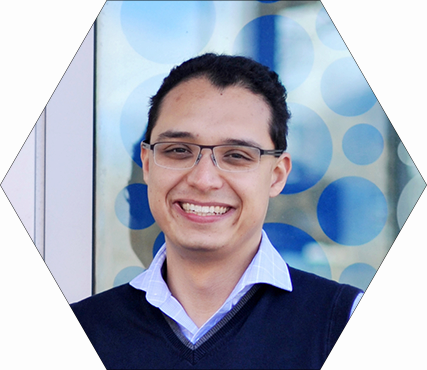Education
- Ph.D. Mechanical Engineering, Massachusetts Institute of Technology, 2012
- M.S. Mechanical Engineering, Massachusetts Institute of Technology, 2008
- M.S. Electrical Engineering and Computer Science, Massachusetts Institute of Technology, 2008
- B.S. Mechanical Engineering, Oregon State University, 2004
Background
Dr. Wood joined Georgia Tech as an Assistant Professor in August, 2015. Prior to his current appointment, he was a postdoctoral fellow at the Beth Israel Deaconess Medical Center, Massachusetts General Hospital, and Harvard Medical School. There he used systems biology to elucidate novel signaling mechanisms in Alzheimer’s disease and intestinal inflammation. Dr. Wood received his Ph.D. in mechanical engineering at the Massachusetts Institute of Technology, where he developed and used a microfluidic platform to identify dominant mechanisms governing vascular geometry during early vascular growth.
Research
- Bioengineering: Vasculature, inflammation, systems biology, Alzheimer’s disease, inflammatory bowel disease
Dr. Wood’s research focuses on applying systems analysis approaches and engineering tools to identify novel clinical therapeutic targets for inflammatory diseases. These diseases, such as Alzheimer’s disease (AD) and inflammatory bowel disease (IBD), result in expansive physiological changes and are genetically complex. As a result, the development of therapeutic strategies has been challenging. By combining novel engineered in vitro platforms, mouse models, and multivariate computational systems analyses, we will be able to 1) capture a holistic systems-level understanding of these complex diseases and 2) isolate specific mechanisms driving each disease. The ultimate goal of Dr. Wood’s laboratory is to use these tools to identify new mechanisms driving disease onset and progression that will translate to clinically effective therapeutic strategies.
The Wood lab views the identification of new mechanisms as a closed-loop process that begins with analysis of human or mouse tissues. This analysis then informs tightly controlled in vitro tissue culture experiments in microfluidic assays and results in therapeutic strategies that will be translated to treatments in vivo. The first step consists of broad molecular analysis of inflamed tissues using state-of-the-art technologies, including multiplexed immunoassays, mass spectrometry and cytometry by time-of-flight (CyTOF). These data provide an extensive characterization of the disease. Computational systems analysis techniques are essential for identifying the molecular analytes that are most strongly related to disease state. Next, key analytes, or groups of analytes, identified from systems analysis are introduced into engineered microfluidic cell culture platforms to identify how they affect function and molecular signaling of specific cell types relevant to the disease. Microfluidic platforms enable the formation of geometries and cell-cell interactions that resemble the in vivo microenvironment, while enabling modulation of environmental conditions and cellular responses that cannot be easily achieved in vivo. By correlating inputs to the microfluidic assay with cellular responses, it will be possible to identify new mechanisms connecting the inflamed tissue microenvironment to functional cellular responses. These analyses will lead us to identify therapeutic strategies that will then be tested for efficacy in vivo.
-
Rohsenow Graduate Fellowship at MIT, 2004.
-
Diversity Achievement Scholarship at OSU, 2002-2004.
-
School of Engineering Scholarship at OSU, 2003.
- Southwestern Oregon Repeater Association Scholarship, 2002.
-
Southwestern Oregon Repeater Association Scholarship, 2001.
-
Best Student Paper Finalist (1st annual Dynamic Systems and Control Conference, Ann Arbor, MI, 2008.)
-
Best Paper and Best Student Paper Award Finalist (1st International Conference on Biomedical Robotics and Biomechantronics (BioRob), Scottsdale, AZ, 2008.)
- Wood, L.,Winslow, A., Strasser, S., 2015. “Systems Biology of Neurodegenerative Diseases,” Integrative Biology (Invited Review), 7, 758-75.
- Jun, H., Roy, J., Smith, T., Wood, L., Lane, K., Woolfenden, S., Punko, D., Bronson, R., Haigis, K., Breton, S., Charest, A., “ROS1 signaling regulated epithelial differentiation in the epididymis,” Endocrinology, 9 3661-73.
- Cho, C., Hashimoto, T., Wong, E., Hori, Y., Wood, L., Zhao, L., Haigis, K., Hyman, T., Irimia, D., 2013. Microfluidic Chemotaxis Platform for Differentiating the Roles of Soluble and Bound Amyloid-β on Microglial Accumulation, Nature Scientific Reports 3, 1823.
- Kim, M., Kim, C., Wood, L., Neal, D., Kamm, R., and Asada, H., 2012. Integrating focal adhesion dynamics, cytoskeleton remodeling, and actin motor activity for predicting cell migration on 3D curved surfaces of the extracellular matrix, Integrative Biology 4, 1386-97.
- Wood, L., Ge, R., Kamm, R., and Asada, H., 2012. Nascent Vessel Elongation rate is Inversely Related to Diameter in In Vitro Angiogenesis, Integrative Biology 4,1081-9.
- Farahat, W.*, Wood, L.*, Zervantonakis, I., Ong, S., Schor, A., Kamm, R., and Asada, H., 2012. Ensemble Analysis Of Angiogenic Growth In Three-Dimensional Microfluidic Cell Cultures. PLoS One 7, e37333. doi:10.1371/journal.pone.0037333. *Equally contributing first and second authors.
- Wood, L.and Asada H., 2011. Cellular Stochastic Control of the Collective Output of a Class of Distributed Hysteretic Systems. Journal of Dynamic Systems, Measurement, and Control 133, 061011.
- Wood, L., Kamm, R., and Asada, H., 2011. Stochastic Modeling and Identification of Emergent Behaviors of an Endothelial Cell Population in Angiogenic Pattern Formation. International Journal of Robotics Research 30, 659-677.
- Wood, L., Das, A., Kamm, R., and Asada, H., 2009. A Stochastic Broadcast Feedback Approach to Regulating Cell Population Morphology for Microfluidic Angiogenesis Platforms. IEEE Transactions on Bio-Medical Engineering 56, 2299-2303.
- R. Kamm, H. Asada, H. Farahat, I. Zervantonakis, L. Wood, C. Kothapalli, S. Chung, J. Macklis, S. Tharin, J. Varner, Y. Park, K. Lee, L. Nguyen, 2014 “Device For High Throughput Investigations Of Multi-Cellular Interactions,” US Patent Application, Pub. No. 20140057311.

